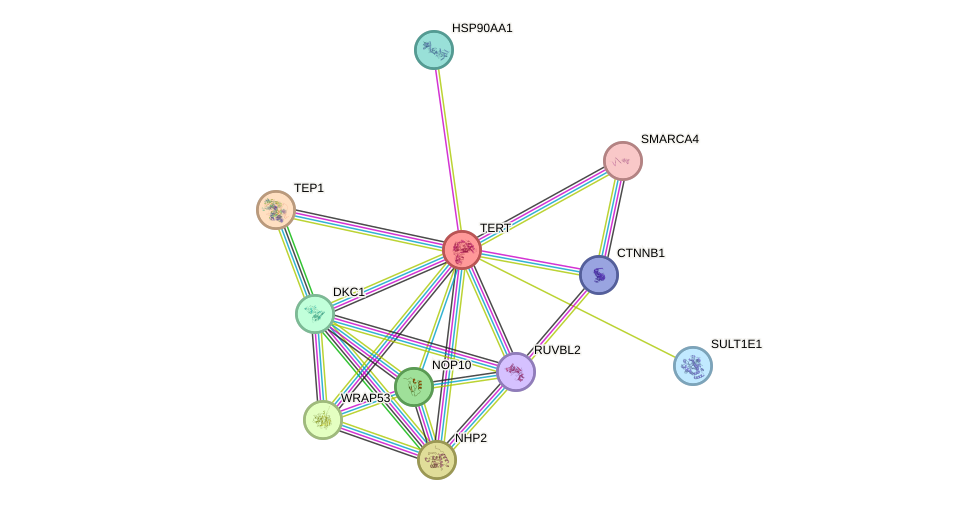GenAge entry for TERT (Homo sapiens)
Gene name (HAGRID: 8)
- HGNC symbol
- TERT
- Aliases
- TRT; TP2; TCS1; hEST2; EST2
- Common name
- telomerase reverse transcriptase
Potential relevance to the human ageing process
- Main reason for selection
- Entry selected based on evidence directly linking the gene product to ageing in a cellular model system
- Description
Telomerase repairs/elongates the telomeres and is crucial in cellular proliferation. TERT expression is sufficient to overcome cellular senescence in culture [24], but overexpression of TERT in mice does not extend longevity [30]. Most human cell lines have low or insignificant levels of TERT while cancer cells often have high levels [102]. TERT expression in primary human fibroblasts results in a linear increase in DNA methylation age with cell population doubling number, indicating that TERT may also play a role in regulating the epigenetic clock [4504].
Cardiac-specific Tert activation after myocardial infarction in adult mice results in attenuated cardiac dilation, improved ventricular function, smaller infarct scars and increased mouse survival [3624]. Tert expression in a mouse model of pulmonary fibrosis improved lung function and lowered inflammation and fibrosis in addition to lowering DNA damage, apoptosis and senescence [4505]. In humans, mutations in TERT have been linked to aplastic anaemia [1465]. As such, TERT appears to be an important player in cellular proliferation, even if its relation to human ageing remains obscure.
Cytogenetic information
- Cytogenetic band
- 5p15.33
- Location
- 1,253,147 bp to 1,295,069 bp
- Orientation
- Minus strand
Protein information
- Gene Ontology
-
Process: GO:0000723; telomere maintenance
GO:0001172; transcription, RNA-templated
GO:0006278; RNA-dependent DNA biosynthetic process
GO:0007004; telomere maintenance via telomerase
GO:0007005; mitochondrion organization
GO:0010629; negative regulation of gene expression
GO:0022616; DNA strand elongation
GO:0030177; positive regulation of Wnt signaling pathway
GO:0030422; production of siRNA involved in RNA interference
GO:0031647; regulation of protein stability
GO:0032092; positive regulation of protein binding
GO:0032774; RNA biosynthetic process
GO:0042635; positive regulation of hair cycle
GO:0043524; negative regulation of neuron apoptotic process
GO:0045766; positive regulation of angiogenesis
GO:0046326; positive regulation of glucose import
GO:0046686; response to cadmium ion
GO:0051000; positive regulation of nitric-oxide synthase activity
GO:0060253; negative regulation of glial cell proliferation
GO:0070200; establishment of protein localization to telomere
GO:0071456; cellular response to hypoxia
GO:0071897; DNA biosynthetic process
GO:0090399; replicative senescence
GO:1900087; positive regulation of G1/S transition of mitotic cell cycle
GO:1902895; positive regulation of pri-miRNA transcription from RNA polymerase II promoter
GO:1903620; positive regulation of transdifferentiation
GO:1903704; negative regulation of production of siRNA involved in RNA interference
GO:1904707; positive regulation of vascular smooth muscle cell proliferation
GO:1904751; positive regulation of protein localization to nucleolus
GO:1904754; positive regulation of vascular associated smooth muscle cell migration
GO:1904837; beta-catenin-TCF complex assembly
GO:2000352; negative regulation of endothelial cell apoptotic process
GO:2000648; positive regulation of stem cell proliferation
GO:2000773; negative regulation of cellular senescence
GO:2001240; negative regulation of extrinsic apoptotic signaling pathway in absence of ligand
Cellular component: GO:0000333; telomerase catalytic core complex
GO:0000781; chromosome, telomeric region
GO:0000783; nuclear telomere cap complex
GO:0000784; nuclear chromosome, telomeric region
GO:0005634; nucleus
GO:0005654; nucleoplasm
GO:0005697; telomerase holoenzyme complex
GO:0005730; nucleolus
GO:0005886; plasma membrane
GO:0016605; PML body
GO:0031379; RNA-directed RNA polymerase complex
GO:0042645; mitochondrial nucleoid
GO:1990572; TERT-RMRP complex
Hide GO termsFunction: GO:0000049; tRNA binding
GO:0001223; transcription coactivator binding
GO:0003677; DNA binding
GO:0003720; telomerase activity
GO:0003721; telomerase RNA reverse transcriptase activity
GO:0003723; RNA binding
GO:0003964; RNA-directed DNA polymerase activity
GO:0003968; RNA-directed 5'-3' RNA polymerase activity
GO:0005515; protein binding
GO:0016779; nucleotidyltransferase activity
GO:0042162; telomeric DNA binding
GO:0042803; protein homodimerization activity
GO:0046872; metal ion binding
GO:0070034; telomerase RNA binding
Protein interactions and network
- Protein-protein interacting partners in GenAge
- TP53, TERC, AKT1, HSP90AA1, PML, TERF1, XRCC5, XRCC6, FOXO3, RELA, HSPA1A, YWHAZ, MDM2, MTOR, ATR, STUB1
- STRING interaction network
Retrieve sequences for TERT
Homologs in model organisms
- Danio rerio
- tert
- Mus musculus
- Tert
- Rattus norvegicus
- Tert
- Saccharomyces cerevisiae
- EST2
- Schizosaccharomyces pombe
- trt1
In other databases
- GenAge model organism genes
- A homolog of this gene for Mus musculus is present as Tert
- LongevityMap
- This gene is present as TERT
- CellAge
- This gene is present as TERT

